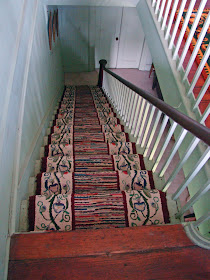I'd seen this old mansion in Montgomery as a youngster, but never had the chance to see the inside of it, much less photograph it as an adult, when I could appreciate it... and then an acquaintence with the historical society there called me with a rare opportunity... I was there in less than an HOUR!
Known as "Magnolia," the house was constructed by Peter Willis and his slaves, and furnished with items he shipped all the way from New York. Later Willis' daughter Magnolia, named after the house, married George Sealy, and his company, Magnolia Oil was named for her. What I saw inside was a jaw-dropping Texas antique collection, much of it sitting just as it had been arranged by Anna Weisinger, and left untouched for years. Mrs. Weisinger was a knowledgable collector, and had kept the house original and in keeping with the period.
The experience was such a priviledge, from walking up the stairs on Mrs Weisinger's hand-hooked runner, to inspecting her collection of Kirbee Pottery.
Perhaps the most exciting find, for me, was this little chunk of fired clay... found on "Juggery Creek" not far away... where the Kirbee Pottery operated. It shows just how coarse and red the clay was here. This is an important clue to identifying stoneware from this region.
This was found in 1971, probably during a dig led by University of Texas archeologists. Perhaps a piece of kiln furniture, this was placed in the kiln before firing to separate vessels, or level them, and keep one from leaning over and falling into another.
For everyone else, one of the most fascinating items would be this fabulous early hand-inked Texas Masonic apron. The artist who embellished this silk artifact was one of true talent and craftsmanship. This draftsman not only understood masonic symbols, but perspective, human anatomy and chiarascuro. Few Texans of that period possessed this knowledge. It might have been Dr. Charles Bellinger Stewart, Montgomery's favorite son who designed the Texas flag. But I have never seen any artwork by him, other than that. Another candidate could, ironically, be William Quesenbury, the artist written about in the blog below...
Now that's a WOW!
A stack of rare, cased, tinted Texas ambrotypes. One is of William Landrum, a relative, and early Texas pioneer.
Thanks to Dudley for calling me about this rare chance to see such things, intact, before they are swept away forever. And thanks again to Mrs. Frank, who so graciously let a stranger in her door.
Hopefully, some divine force will keep an eye on these precious items.











No comments:
Post a Comment
Tell me your thoughts!